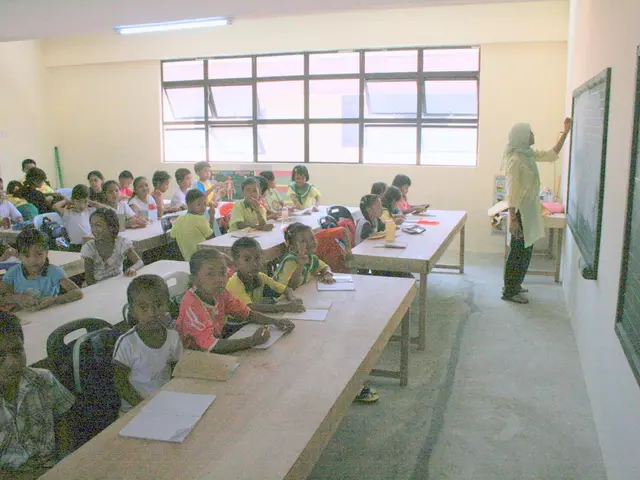Age-Based Car Seat Classification: A Handbook for Selecting Appropriate Car Seats
Driving with the little ones? Buckle 'em up safe and sound! this guide’ll outline various child safety features to keep your kids snug and secure during travel.
A child restraint device, like a car seat or booster, is essential for your young one's protection while on the road. These devices come in assorted forms; some even transform as your kiddo grows, while others require replacements each growth stage. Generally, three types of child car seats exist.
Types of Car Seats
There's a plethora of safety seats tailored to a growing child's requirements. Here’s a lowdown on the far from uncommon types of infant car seats:
Rear-Facing Car Seats (Infant Seats)
Designed for newborns till the age of one or weighing over 10 kg (22 lbs), rear-facing car seats are a must-have for infants. These seats accommodate a basket-like shape, an easy-carry handle, and sometimes, rocking or chair conversion options for when your munchkin outgrows the initial stage. The rear-seat position ensures proper support for developing heads and necks of infants.
Forward-Facing Car Seats (Toddler Seats)
Once your child turns a year or tips the scales at 20 lbs, it's time for a transformation to a forward-facing child restraint (toddler seat). These seats protect toddlers from being propelled forward in vehicles. Premium versions include heavy padding to cushion the neck during car crashes, collisions, or sudden stops. Some forward-facing seats can be assembled into booster seats as your child grows beyond the toddler stage.
Booster Seats
Booster seats are ideal for kids aged 3 and up or those yet to reach the average adult height. These seats directly connect with the car's seatbelt without a harness system, elevating the child's height to prevent friction between the cross belt and the child's neck. In most cases, parents are advised to keep their kiddo secured in a booster seat until they’re as tall as an average adult.
Convertible Child Car Seats
Convertible child car seats can morph from a rear-facing seat to a forward-facing child safety seat as the child grows. These seats are usually larger than rear-facing-only seats and don’t have detachable bases or handles. Some models can accommodate children weighing up to 40-50 lbs in the rear-facing position, allowing them to fit larger infants and toddlers.
Combination Child Car Seats
The combination car seat serves as a forward-facing car seat with an inbuilt harness, or a booster seat with a lap-sash adult seatbelt, with the harness removed. These seats are designed exclusively for forward-facing use, with a child secure in the harness until they reach the maximum height or weight limit established by the manufacturer. A combination seat will come equipped with a specified seat belt or lower anchor belt pathway for installation.
All-in-One Seats
All-in-one seats offer three distinct configurations: rear-facing, forward-facing, or booster (seats without a harness). When used in the rear-facing position, they are very similar to convertible seats. These types of seats can accommodate children up to 50-65 lbs.
Selecting the Perfect Travel Safety Seat
Consider these factors while purchasing childproofing safety gear for your little one:
- It should fit your child's age, height, and weight.
- Properly adjust, fasten, and secure the seat to your vehicle.
- For infants and toddlers under 12 months, rear-facing seats are the safest.
- When choosing an infant car seat, prioritize soft padding, comfort, and strong head and neck support. The seat should snuggly fit your baby, and the seat should fit comfortably within your vehicle.
- If the baby's head reaches the seat's top, consider purchasing a larger model.
- Choose seats that meet approved child safety standards.
Using Safety Seats Appropriately
Although rules concerning child car safety vary across regions, certain guidelines can ensure correct and secure usage:
- Thoroughly analyze the instruction manual.
- Position the child comfortably yet securely within the car seat.
- Strap the child such that there’s plenty of room for two fingers between the straps and the child’s chest.
- Ensure all belts are securely fastened and positioned as per the manual, or they could endanger your child's safety.
- Infant seats should be positioned at a 45-degree angle.
- Replace the car seat promptly when it wears out or your child outgrows it.
Installation Tips for Child Car Seats
When selecting a child car seat, it's wise to be well-versed in features, benefits, and common mistakes to avoid:
Choosing the Right Spot
Place the car seat in the vehicle's rear end, as it's furthest from airbags. Position the car seat in the rear middle row to monitor your child easily and maintain quick access to them.
Buckling up Correctly
Study the seat's instruction manual meticulously and use the harness slots accurately. Properly fasten and secure the straps and chest clip.
Reclining the Seat Correctly
Reclining the car seat is equally important as proper placement and buckling. When you install a car seat in a rear-facing position, recline it according to the manufacturer's recommendations. Infants require a semi-reclined position to maintain open airways. Car seats often include angle indicators or adjustment features to assist with proper reclination. Adjust the angle as your child grows.
Do Not Place the Seat in a Forward-Facing Position
Though it may be tempting to switch your child's car seat to a forward-facing position so you can keep a close eye on them, it's essential for children to remain rear-facing until they reach the assigned height limits.
Use a Tether Strap for a Forward-facing Seat
Regardless of how the seat is installed, always connect a tether strap to the vehicle's tether anchor. This bolsters seat stability during accidents and minimizes movement.
Frequently Asked Questions
1. What's the purpose of a child car seat?
Car crashes frequently cause injuries and fatalities around the globe, with children being the most vulnerable. Adult seat belts are not designed to protect infants or toddlers properly. Child car seats and restraints ensure a safer travel experience for your little one.
2. At what age should children cease using a high-back booster seat?
Once your child reaches the age of 12, approximately 122 cm (4 feet) in height, they can stop using a high-back booster seat.
3. Are backless booster seats legal?
Backless booster seats have been legal since March 2017 for children who are over 125 cm (4 feet 1 inch) tall and weigh over 22 kg (50 lbs).
- For the safety of your child during travel, it's crucial to invest in a convertible child car seat that can transform from a rear-facing seat to a forward-facing seat as your child grows.
- When your child reaches the age of 3 or surpasses the average adult height, consider transitioning them from a booster seat to a safety belt in your vehicle's seat, providing they are tall enough to sit correctly and the seatbelt fits properly across their shoulders and hips.
- Pursue health-and-wellness practices for the entire family, such as introducing a balanced diet and regular physical activities, like sports, to encourage a lifestyle that prioritizes well-being for both parent and child.
- Parenting doesn't only revolve around car safety and childcare; it encompasses various aspects, including family-health and lifestyle choices that contribute to a happy and nurturing environment for your child's growth and development.








